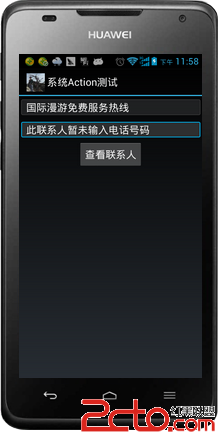編輯:關於Android編程
Gradle:com.squareup.okhttp okhttp2.3.0
compile 'com.squareup.okhttp:okhttp:2.3.0'
private final OkHttpClient client = new OkHttpClient();
public void run() throws Exception {
Request request = new Request.Builder()
.url(http://publicobject.com/helloworld.txt)
.build();
Response response = client.newCall(request).execute();
if (!response.isSuccessful()) throw new IOException(Unexpected code + response);
Headers responseHeaders = response.headers();
for (int i = 0; i < responseHeaders.size(); i++) {
System.out.println(responseHeaders.name(i) + : + responseHeaders.value(i));
}
System.out.println(response.body().string());
}
private final OkHttpClient client = new OkHttpClient();
public void run() throws Exception {
Request request = new Request.Builder()
.url(http://publicobject.com/helloworld.txt)
.build();
client.newCall(request).enqueue(new Callback() {
@Override public void onFailure(Request request, Throwable throwable) {
throwable.printStackTrace();
}
@Override public void onResponse(Response response) throws IOException {
if (!response.isSuccessful()) throw new IOException(Unexpected code + response);
Headers responseHeaders = response.headers();
for (int i = 0; i < responseHeaders.size(); i++) {
System.out.println(responseHeaders.name(i) + : + responseHeaders.value(i));
}
System.out.println(response.body().string());
}
});
}
private final OkHttpClient client = new OkHttpClient();
public void run() throws Exception {
Request request = new Request.Builder()
.url(https://api.github.com/repos/square/okhttp/issues)
.header(User-Agent, OkHttp Headers.java)
.addHeader(Accept, application/json; q=0.5)
.addHeader(Accept, application/vnd.github.v3+json)
.build();
Response response = client.newCall(request).execute();
if (!response.isSuccessful()) throw new IOException(Unexpected code + response);
System.out.println(Server: + response.header(Server));
System.out.println(Date: + response.header(Date));
System.out.println(Vary: + response.headers(Vary));
}
public static final MediaType jsonReq
= MediaType.parse(application/json; charset=utf-8);
OkHttpClient client = new OkHttpClient();
String post(String url, String json) throws IOException {
RequestBody body = RequestBody.create(jsonReq, json);
Request request = new Request.Builder()
.url(url)
.post(body)
.build();
Response response = client.newCall(request).execute();
return response.body().string();
}
public static final MediaType MEDIA_TYPE_MARKDOWN
= MediaType.parse(text/x-markdown; charset=utf-8);
private final OkHttpClient client = new OkHttpClient();
public void run() throws Exception {
RequestBody requestBody = new RequestBody() {
@Override public MediaType contentType() {
return MEDIA_TYPE_MARKDOWN;
}
@Override public void writeTo(BufferedSink sink) throws IOException {
sink.writeUtf8(Numbers
);
sink.writeUtf8(-------
);
for (int i = 2; i <= 997; i++) {
sink.writeUtf8(String.format( * %s = %s
, i, factor(i)));
}
}
private String factor(int n) {
for (int i = 2; i < n; i++) {
int x = n / i;
if (x * i == n) return factor(x) + × + i;
}
return Integer.toString(n);
}
};
Request request = new Request.Builder()
.url(https://api.github.com/markdown/raw)
.post(requestBody)
.build();
Response response = client.newCall(request).execute();
if (!response.isSuccessful()) throw new IOException(Unexpected code + response);
System.out.println(response.body().string());
}
public static final MediaType MEDIA_TYPE_MARKDOWN
= MediaType.parse(text/x-markdown; charset=utf-8);
private final OkHttpClient client = new OkHttpClient();
public void run() throws Exception {
File file = new File(README.md);
Request request = new Request.Builder()
.url(https://api.github.com/markdown/raw)
.post(RequestBody.create(MEDIA_TYPE_MARKDOWN, file))
.build();
Response response = client.newCall(request).execute();
if (!response.isSuccessful()) throw new IOException(Unexpected code + response);
System.out.println(response.body().string());
}
private final OkHttpClient client = new OkHttpClient();
public void run() throws Exception {
RequestBody formBody = new FormEncodingBuilder()
.add(search, Jurassic Park)
.build();
Request request = new Request.Builder()
.url(https://en.wikipedia.org/w/index.php)
.post(formBody)
.build();
Response response = client.newCall(request).execute();
if (!response.isSuccessful()) throw new IOException(Unexpected code + response);
System.out.println(response.body().string());
}
private static final String IMGUR_CLIENT_ID = ...;
private static final MediaType MEDIA_TYPE_PNG = MediaType.parse(image/png);
private final OkHttpClient client = new OkHttpClient();
public void run() throws Exception {
// Use the imgur image upload API as documented at https://api.imgur.com/endpoints/image
RequestBody requestBody = new MultipartBuilder()
.type(MultipartBuilder.FORM)
.addPart(
Headers.of(Content-Disposition, form-data; name= itle),
RequestBody.create(null, Square Logo))
.addPart(
Headers.of(Content-Disposition, form-data; name=image),
RequestBody.create(MEDIA_TYPE_PNG, new File(website/static/logo-square.png)))
.build();
Request request = new Request.Builder()
.header(Authorization, Client-ID + IMGUR_CLIENT_ID)
.url(https://api.imgur.com/3/image)
.post(requestBody)
.build();
Response response = client.newCall(request).execute();
if (!response.isSuccessful()) throw new IOException(Unexpected code + response);
System.out.println(response.body().string());
}
private final OkHttpClient client = new OkHttpClient();
private final Gson gson = new Gson();
public void run() throws Exception {
Request request = new Request.Builder()
.url(https://api.github.com/gists/c2a7c39532239ff261be)
.build();
Response response = client.newCall(request).execute();
if (!response.isSuccessful()) throw new IOException(Unexpected code + response);
Gist gist = gson.fromJson(response.body().charStream(), Gist.class);
for (Map.Entry entry : gist.files.entrySet()) {
System.out.println(entry.getKey());
System.out.println(entry.getValue().content);
}
}
static class Gist {
Map files;
}
static class GistFile {
String content;
}
private final OkHttpClient client;
public CacheResponse(File cacheDirectory) throws Exception {
int cacheSize = 10 * 1024 * 1024; // 10 MiB
Cache cache = new Cache(cacheDirectory, cacheSize);
client = new OkHttpClient();
client.setCache(cache);
}
public void run() throws Exception {
Request request = new Request.Builder()
.url(http://publicobject.com/helloworld.txt)
.build();
Response response1 = client.newCall(request).execute();
if (!response1.isSuccessful()) throw new IOException(Unexpected code + response1);
String response1Body = response1.body().string();
System.out.println(Response 1 response: + response1);
System.out.println(Response 1 cache response: + response1.cacheResponse());
System.out.println(Response 1 network response: + response1.networkResponse());
}
final Call call = client.newCall(request);
call.cancel();
private final OkHttpClient client;
public ConfigureTimeouts() throws Exception {
client = new OkHttpClient();
client.setConnectTimeout(10, TimeUnit.SECONDS);
client.setWriteTimeout(10, TimeUnit.SECONDS);
client.setReadTimeout(30, TimeUnit.SECONDS);
}
private final OkHttpClient client = new OkHttpClient();
public void run() throws Exception {
client.setAuthenticator(new Authenticator() {
@Override public Request authenticate(Proxy proxy, Response response) {
System.out.println(Authenticating for response: + response);
System.out.println(Challenges: + response.challenges());
String credential = Credentials.basic(jesse, password1);
return response.request().newBuilder()
.header(Authorization, credential)
.build();
}
@Override public Request authenticateProxy(Proxy proxy, Response response) {
return null; // Null indicates no attempt to authenticate.
}
});
Request request = new Request.Builder()
.url(http://publicobject.com/secrets/hellosecret.txt)
.build();
Response response = client.newCall(request).execute();
if (!response.isSuccessful()) throw new IOException(Unexpected code + response);
System.out.println(response.body().string());
}
為避免當驗證失敗時多次重試,我們可以通過返回null來放棄驗證:
if (responseCount(response) >= 3) {
return null; // If we've failed 3 times, give up.
}
//添加以下方法
private int responseCount(Response response) {
int result = 1;
while ((response = response.priorResponse()) != null) {
result++;
}
return result;
}
class LoggingInterceptor implements Interceptor {
@Override public Response intercept(Chain chain) throws IOException {
Request request = chain.request();
long t1 = System.nanoTime();
logger.info(String.format(Sending request %s on %s%n%s,
request.url(), chain.connection(), request.headers()));
Response response = chain.proceed(request);
long t2 = System.nanoTime();
logger.info(String.format(Received response for %s in %.1fms%n%s,
response.request().url(), (t2 - t1) / 1e6d, response.headers()));
return response;
}
}
OkHttpClient client = new OkHttpClient(); client.interceptors().add(new LoggingInterceptor());
OkHttpClient client = new OkHttpClient(); client.networkInterceptors().add(new LoggingInterceptor());
 Android開發中RecyclerView模仿探探左右滑動布局功能
Android開發中RecyclerView模仿探探左右滑動布局功能
我在此基礎上優化了部分代碼, 添加了滑動回調, 可自定義性更強. 並且添加了點擊按鈕左右滑動的功能.據說無圖都不敢發文章了.看圖:1:這種功能, 首先需要自己管理布局繼承
 Android菜鳥的成長筆記(8)——Intent與Intent Filter(上)
Android菜鳥的成長筆記(8)——Intent與Intent Filter(上)
Intent代表了Android應用的啟動“意圖”,Android應用將會根據Intent來啟動指定組件,至於到底啟動哪個組件,取決於Intent的各個屬性。 一、顯式的
 RecyclerView下拉刷新上拉加載
RecyclerView下拉刷新上拉加載
一 、前言最近實在太忙,一個多禮拜沒有更新文章了,於是今晚加班加點把demo寫出來,現在都12點了才開始寫文章。1.我們的目標把RecyclerView下拉刷新上拉加載更
 Android根據屏幕寬度,按比例縮放圖片
Android根據屏幕寬度,按比例縮放圖片
ImageView有scaleType屬性可以縮放圖片,讓圖片鋪滿屏幕寬度,但是會出現壓縮或裁剪的情況。ImageView的scaleType的屬性分別是ma